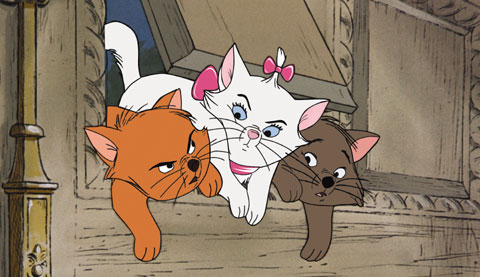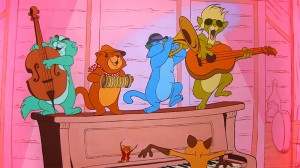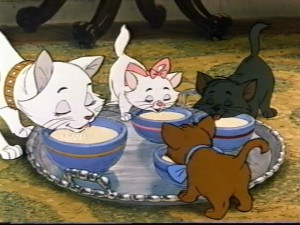Directed by Wolfgang Reitherman
Written by Ken Anderson, Larry Clemmons, Eric Cleworth, Vance Garry, Tom McGowan, Tom Rowe, Julius Svendsen, Frank Thomas, and Ralph Wright
Starring Phil Harris, Eva Gabor, Scatman Crothers
Complacency is always a dangerous tone to strike in filmmaking. Combined with cheapness, it can be a killer. Those two concepts are what stand out most of all from the Wolfgang Reitherman era of Walt Disney Pictures. For various reasons, most of which were beyond Reitherman’s control, most of the films from Walt Disney Pictures between 1959’s Sleeping Beauty and 1989’s The Little Mermaid felt cheap and lazy. (Being fair, Reitherman’s time at the company ended, for the most part, with 1977’s The Rescuers, but the four films between that and Mermaid have varying aspects of laziness on display, I think.) And make no mistake: the word “cheap” does not need to be a criticism. Independent filmmaking, for example, sprung up because people were so determined and dedicated to their craft and storytelling that they made the films work despite not having gargantuan budgets. A great filmmaker doesn’t need a hundred-million-dollar budget to make great films.
But a great filmmaker can drown in inertia. I don’t even know that I’m saying Wolfgang Reitherman is a great filmmaker. I think you could argue that the fabled Nine Old Men collectively were a great filmmaker. By themselves, Frank Thomas or Ollie Johnston or Milt Kahl or the others were arguably quite talented animators, but parts of a whole. Wolfgang Reitherman couldn’t be a great filmmaker by himself (or he never proved himself to be); he needed the collective to create something you could consider classic. I would, of course, posit that none of the movies in that 30-year fallow period in Walt Disney Feature Animation’s history are classic (even The Many Adventures of Winnie the Pooh, a film I treasure, isn’t something I’d consider as one of Disney’s finest). I know, however, that a lot of people, including my co-hosts, are big fans of movies like The Sword in the Stone, Robin Hood, and The Rescuers.
I want to clarify—even though I really shouldn’t have to, because this is automatically an opinion piece, but whatever—that what I’m saying here isn’t a declarative fact. I know this is my opinion. So I’ll couch this in saying that I wonder if people are blinded by their nostalgia of these specific films. You can be nostalgic about something that is also legitimately well-done. Some of Disney’s best films are actually as good as we remember. We may have built-in feelings based on watching a film during our childhoods, but some of those films do hold up. I don’t know how anyone can think the Disney animated films from, especially, the 1960s and 1970s hold up, separate from any childhood memories. I am aware that this may be a minority argument, but the stories are frequently derivative, the characters are ill defined, and the animation is deliberately sloppy.
Regarding the animation, many people would accurately argue that the animation style present in the 1960s and 1970s films from Disney is intentional. Mike invoked the term on the show, but some people may not fully be aware of what xerography is. It was pioneered by Ub Iwerks back in the late 1950s as a way to keep the animation department at Disney solvent—Sleeping Beauty was an extraordinarily expensive film that wasn’t a huge hit upon its initial release. Xerography takes out the middleman in animation, so that rough sketches can essentially be copied into animation cels, thus making the work a lot simpler and a lot cheaper. And while I appreciate the necessity within the Walt Disney Company to a) not spend a boatload of cash on every animation project and b) to not shutter the animation department entirely, I’d argue that the process of xerography came at the expense of making quality films. I said it on the show, and I’ll say it here: outside of The Jungle Book and The Many Adventures of Winnie the Pooh, I’m not the biggest fan of Disney’s animated projects during these two decades.
Why does The Jungle Book get a pass, you may ask. It comes at the height of the xerography period, no doubt. And like The Aristocats and 1973’s Robin Hood, it largely coasts on the laid-back charms of Phil Harris’ voice. I think it boils down to The Jungle Book being first. As I mentioned on the show, a good chunk of The Aristocats feels like a rehash of story points from the story of Mowgli the man-cub, at least the Disney version of that Rudyard Kipling story. The same goes for Robin Hood, which literally featured old animation cels in a key dancing sequence, from The Jungle Book all the way back to Snow White and the Seven Dwarfs. I get that Disney needed to save money—while the Disneyland and Walt Disney World theme parks might have been making a decent amount of cash in the early 1970s, the company didn’t have enough to spread around to animation—but this goes beyond typical xerography and turns into an almost smug attitude: “Who cares if we copy our old material? People will still watch the new movie.”
Something that makes me recoil about The Aristocats is that perceived smugness. It’s not just in the animation—granted, the xerography here isn’t nearly as egregious as in Robin Hood—but in the style of even the opening-credits song. Famed singer Maurice Chevalier came out of retirement to sing the title track, and while it sounds…well, a lot like Maurice Chevalier (one of the Sherman brothers sang the song to Chevalier by doing an impersonation of his voice, and Chevalier said—probably in jest, but still—he simply impersonated the Sherman impersonation) crooning about cats. Something about the way Chevalier says “Aristocats” oozes a level of self-satisfaction, one that is absolutely not earned by the film following those credits.
I think the general reputation this film has earned isn’t deserved, frankly. I didn’t get into this on the podcast, but I do wonder how much of people’s fervent love of The Aristocats is partly due to a posthumous deification of Walt Disney. Though Disney had passed away just over 4 years before the film opened in theaters around the country, he had been involved in the initial stages of its production. Somehow, folks have bestowed upon the film a badge of honor, forgiving its faults because it was something Walt shepherded from the beginning. I don’t mean to say that everyone who likes The Aristocats feels this way, but I don’t honestly know why it should matter that Walt Disney himself was involved in its production. I said something along these lines when referring to a special feature on the Blu-ray for the film about the Sherman brothers, in which they’re dubbed the Aristocats of Disney music, but that sounds like an insult to me, not a compliment.
Part of that is because the music in The Aristocats isn’t that impressive; moreover, the song most people remember, “Ev’rybody Wants to be a Cat,” wasn’t even written by the Shermans. Admittedly, the first half of that song is fairly tuneful, but it’s obscured by a loud and grating finale that climaxes in the characters apparently being able to jump hard enough to send a piano sailing down four flights of an apartment building. Frankly, the Shermans contributed in far more notable ways to other Disney classics like Mary Poppins or The Jungle Book. Sure, they coaxed Maurice Chevalier out of retirement, but is that reason enough to associate them with this film?
Perhaps the greatest failing of this film is its story. In our show, Mike posited that the character who goes through the most change in the movie is Thomas O’Malley, voiced by Harris. And while I cannot argue with Mike—even when we first meet him, O’Malley seems like he’s ready to be a reformed scoundrel as opposed to just a scoundrel—that this is true, I’m not sure that’s in the film’s favor. The movie runs just 78 minutes (I say “just” even though almost every single Disney animated film barely comes close to the 90-minute mark), and we don’t meet O’Malley for the first third. He’s obviously important to the story, as he becomes not only a heroic figure but Duchess’s love interest. But the movie isn’t called Thomas O’Malley. The story, at least based on the title and first 30 minutes, is not about how he gets roped into domesticity. It’s about how cats survive the wheelings and dealings of a selfish and greedy butler.
If the movie is more about Thomas than anyone else, intentional or otherwise, it’s a failing. Couldn’t the film attempt to have more than one character change? Why not focus equally on how at least Duchess deals with being out in the real world? You could assume—and I wouldn’t blame you for doing so—that the story will be about how she’s forced to accept that the world doesn’t follow the rules of her otherwise pampered lifestyle. Duchess does experience the real world; however, she doesn’t change by the end of the film. She’s gotten a new accessory in her life, in the form of a male cat. But she’s the same cat. And her kittens, Berlioz, Marie, and Toulouse, are the same would-be ruffians, mixing high and low culture in their attitudes. They’re the same at the end as they are at the beginning. There’s no arc for the title characters, and I’m not sure there’s a good reason as to why.
I may well have confused my co-hosts in my supreme distaste for this film, simply because I’m a cat owner. I know that Mike and Gabe were ribbing me, but I’m sure there are actually people out there who’d question why someone who so loves felines doesn’t love Disney’s first serious cat-centric story. (And as I mentioned offhandedly on the podcast, I’m no fan of Oliver & Company, either.) In a way, I think such a question belies the laziness on display here. I’m supposed to like The Aristocats, perhaps, because I’m a cat person. See? Cats! It’s about cats! You like cats, so you should like this movie about cats! Making this assumption is just proof that the animators didn’t care that much about trying to make something worthy of an audience member’s appreciation. I can like something outside of a movie, but dislike a movie about that subject. I don’t really think there’s too much nuance to that notion, but I fear that such complexity, by not being present in any way during The Aristocats, would elude the filmmakers behind it.




